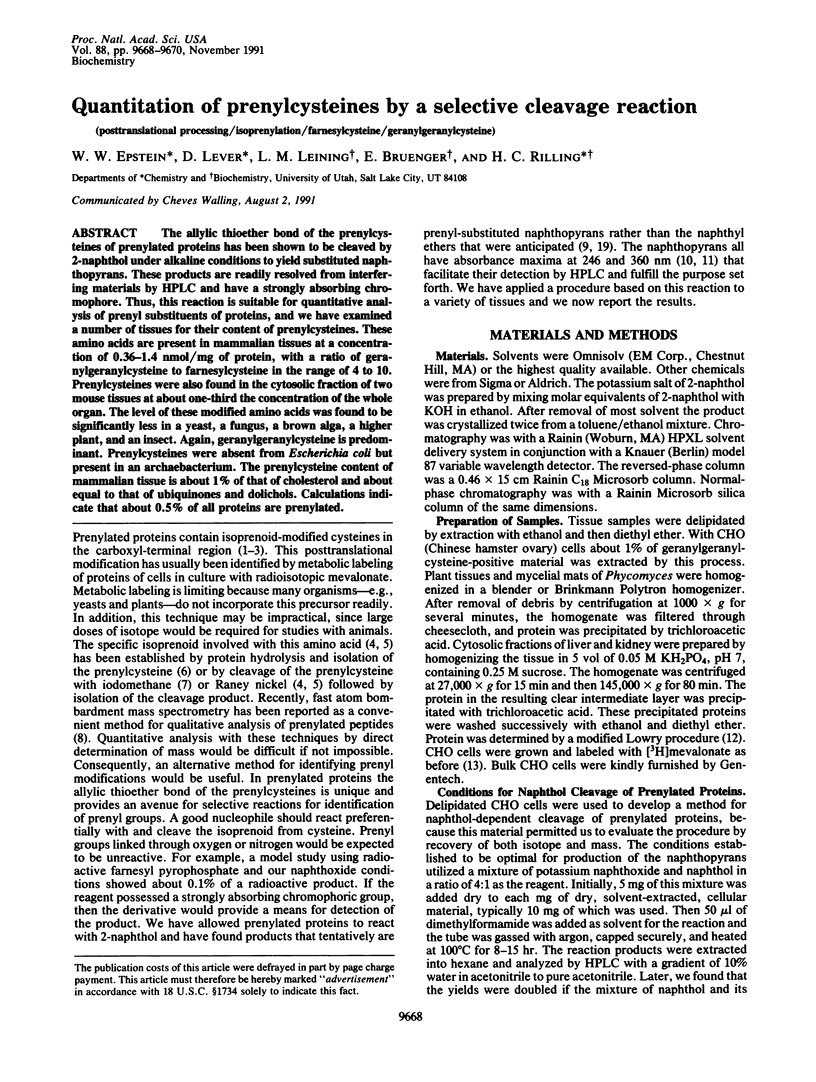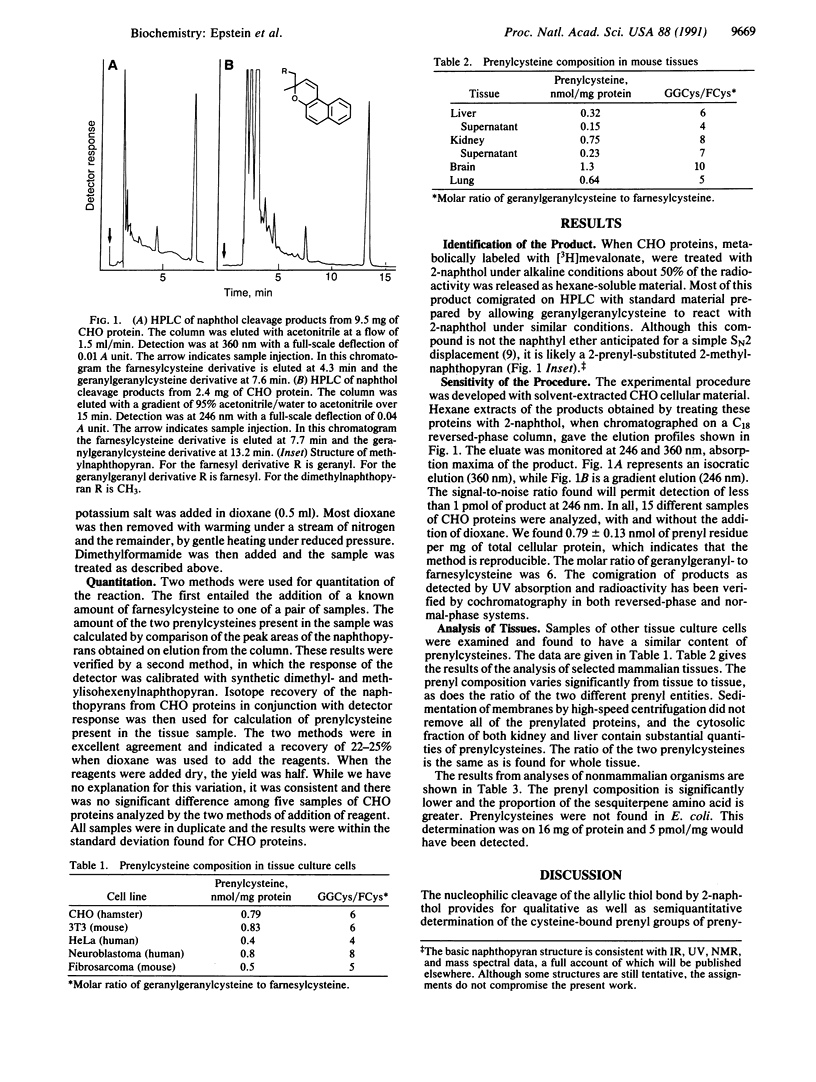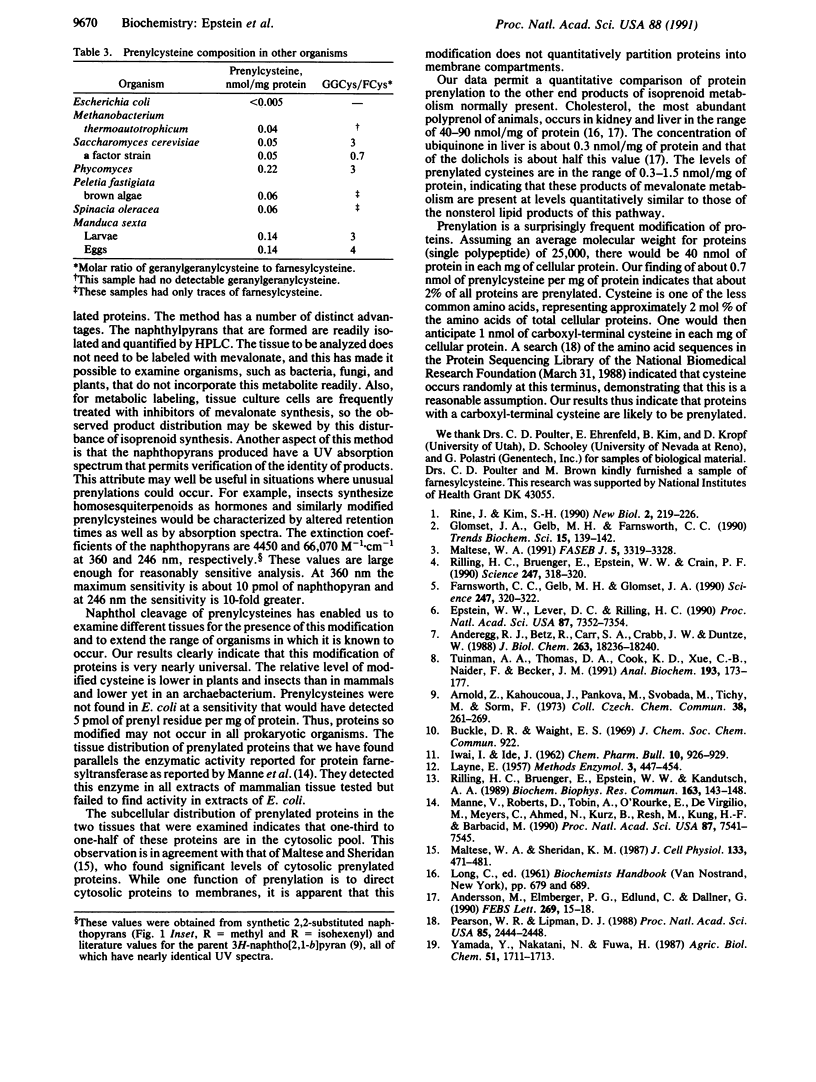Abstract
The allylic thioether bond of the prenylcysteines of prenylated proteins has been shown to be cleaved by 2-naphthol under alkaline conditions to yield substituted naphthopyrans. These products are readily resolved from interfering materials by HPLC and have a strongly absorbing chromophore. Thus, this reaction is suitable for quantitative analysis of prenyl substituents of proteins, and we have examined a number of tissues for their content of prenylcysteines. These amino acids are present in mammalian tissues at a concentration of 0.36-1.4 nmol/mg of protein, with a ratio of geranylgeranylcysteine to farnesylcysteine in the range of 4 to 10. Prenylcysteines were also found in the cytosolic fraction of two mouse tissues at about one-third the concentration of the whole organ. The level of these modified amino acids was found to be significantly less in a yeast, a fungus, a brown alga, a higher plant, and an insect. Again, geranylgeranylcysteine is predominant. Prenylcysteines were absent from Escherichia coli but present in an archaebacterium. The prenylcysteine content of mammalian tissue is about 1% of that of cholesterol and about equal to that of ubiquinones and dolichols. Calculations indicate that about 0.5% of all proteins are prenylated.
Full text
PDF


Selected References
These references are in PubMed. This may not be the complete list of references from this article.
- Anderegg R. J., Betz R., Carr S. A., Crabb J. W., Duntze W. Structure of Saccharomyces cerevisiae mating hormone a-factor. Identification of S-farnesyl cysteine as a structural component. J Biol Chem. 1988 Dec 5;263(34):18236–18240. [PubMed] [Google Scholar]
- Andersson M., Elmberger P. G., Edlund C., Kristensson K., Dallner G. Rates of cholesterol, ubiquinone, dolichol and dolichyl-P biosynthesis in rat brain slices. FEBS Lett. 1990 Aug 20;269(1):15–18. doi: 10.1016/0014-5793(90)81107-y. [DOI] [PubMed] [Google Scholar]
- Epstein W. W., Lever D. C., Rilling H. C. Prenylated proteins: synthesis of geranylgeranylcysteine and identification of this thioether amino acid as a component of proteins in CHO cells. Proc Natl Acad Sci U S A. 1990 Oct;87(19):7352–7354. doi: 10.1073/pnas.87.19.7352. [DOI] [PMC free article] [PubMed] [Google Scholar]
- Farnsworth C. C., Gelb M. H., Glomset J. A. Identification of geranylgeranyl-modified proteins in HeLa cells. Science. 1990 Jan 19;247(4940):320–322. doi: 10.1126/science.2296721. [DOI] [PMC free article] [PubMed] [Google Scholar]
- Glomset J. A., Gelb M. H., Farnsworth C. C. Prenyl proteins in eukaryotic cells: a new type of membrane anchor. Trends Biochem Sci. 1990 Apr;15(4):139–142. doi: 10.1016/0968-0004(90)90213-u. [DOI] [PubMed] [Google Scholar]
- IWAI I., IDE J. Studies on acetylenic compounds. XXIII. A new ring closure of 2-propynyl ethers. Chem Pharm Bull (Tokyo) 1962 Oct;10:926–933. doi: 10.1248/cpb.10.926. [DOI] [PubMed] [Google Scholar]
- Maltese W. A., Sheridan K. M. Isoprenylated proteins in cultured cells: subcellular distribution and changes related to altered morphology and growth arrest induced by mevalonate deprivation. J Cell Physiol. 1987 Dec;133(3):471–481. doi: 10.1002/jcp.1041330307. [DOI] [PubMed] [Google Scholar]
- Manne V., Roberts D., Tobin A., O'Rourke E., De Virgilio M., Meyers C., Ahmed N., Kurz B., Resh M., Kung H. F. Identification and preliminary characterization of protein-cysteine farnesyltransferase. Proc Natl Acad Sci U S A. 1990 Oct;87(19):7541–7545. doi: 10.1073/pnas.87.19.7541. [DOI] [PMC free article] [PubMed] [Google Scholar]
- Pearson W. R., Lipman D. J. Improved tools for biological sequence comparison. Proc Natl Acad Sci U S A. 1988 Apr;85(8):2444–2448. doi: 10.1073/pnas.85.8.2444. [DOI] [PMC free article] [PubMed] [Google Scholar]
- Rilling H. C., Breunger E., Epstein W. W., Crain P. F. Prenylated proteins: the structure of the isoprenoid group. Science. 1990 Jan 19;247(4940):318–320. doi: 10.1126/science.2296720. [DOI] [PubMed] [Google Scholar]
- Rilling H. C., Bruenger E., Epstein W. W., Kandutsch A. A. Prenylated proteins: demonstration of a thioether linkage to cysteine of proteins. Biochem Biophys Res Commun. 1989 Aug 30;163(1):143–148. doi: 10.1016/0006-291x(89)92111-6. [DOI] [PubMed] [Google Scholar]
- Rine J., Kim S. H. A role for isoprenoid lipids in the localization and function of an oncoprotein. New Biol. 1990 Mar;2(3):219–226. [PubMed] [Google Scholar]
- Tuinman A. A., Thomas D. A., Cook K. D., Xue C. B., Naider F., Becker J. M. Mass spectrometric signature of S-prenylated cysteine peptides. Anal Biochem. 1991 Mar 2;193(2):173–177. doi: 10.1016/0003-2697(91)90004-d. [DOI] [PubMed] [Google Scholar]


